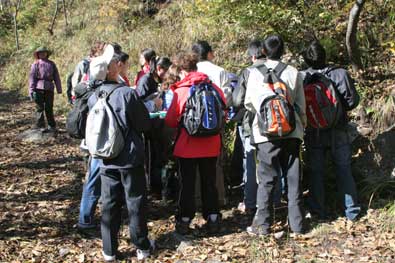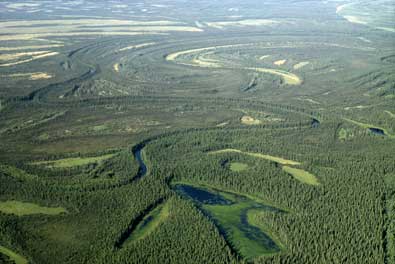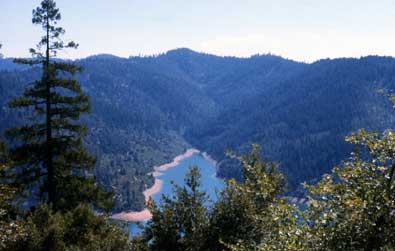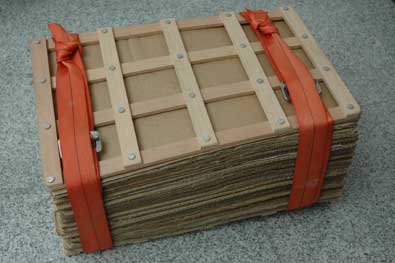The CLAMP calibration files are made up of samples from living vegetation in which the leaves have been collected in a specified way. The rules (protocols) governing how vegetation is sampled are designed to provide transparency and consistency, and therefore limit spurious data that would otherwise contribute to statistical 'noise'. This noise degrades precision when deriving climate estimates. As well as providing calibration data, sampling modern vegetation can also provide test sites to evaulate CLAMP performance in different climatic regimes, and with different vegetation types. Such sampling also allows for useful and stimulating class exercises.
Making a collection of modern vegetation for CLAMP1) Name and describe the site. Take note of the latitude/longitude and altitude. Lat/Longs should use the WGS 84 standard and be in decimal degrees (most GPS instruments can be set to deliver these automatically) because this is the form that is used to generate gridded climate data using the BRIDGE site. Record altitude in metres. Also make notes as to type of vegetation (natural stand/undisturbed/disturbed/regrowth etc), soil type and depth, and any other useful information. To see the kind of information previously recorded go to the Google Earth page and install the CLAMP .kmz file. In mountainous areas always make a note of the aspect of the slope being sampled. North-facing slopes have very different local microclimates than south-facing slopes. Exactly what this difference is will depend on which hemisphere the sample is from and, to some extent, the latitude and altitude. 2) Samples collected in the vicinity of a meteorological station should have the details of the station added, particularly if the 30-year climate normals for that station are going to be used for calibration. 3) It is OK to collect along paths. Paths, like streams, can produce 'light breaks' in the canopy which in turn affect local humidity and temperature. You will tend to find more variety in leaf form in such areas than under a closed forest canopy. Ideally, however, collect in swamps and along stream, river and lake margins because these water bodies provide ideal settings for fossilization and most fossil leaf assemblages are derived from vegetation growing close to water.
Collecting4) At each site collect the leaves of at least 20 woody dicot species. Beyond that, the more species that are represented the better. As far as is possible collect leaves that reflect the full range of morphologies present in the vegetation. Using separate plastic bags for each species saves confusion later as to whether certain leaves represent one species or another. If a species has leaves that display a great variation in shape and size then confusion can occur very easily. One larger bag can hold the smaller ones making up the completed collection. It is also a good idea to try and keep the leaves flat and unfolded when putting them into a bag. This helps later in arranging the material for pressing (see section 9 below).
6) Collect only the leaves of woody dicot species. Herbs and monocots are not included in CLAMP. If in doubt whether a bush or vine is woody, check at the base for signs of regrowth.
Pressing9) For calibration purposes leaves need to be pressed. Carefully place them between newspapers as soon as possible after collection. These will become a 'reference' collection. Such reference collections for CLAMP are already housed in the Natural History Museum Smithsonian Institution, Washington, DC., the Birbal Sahni Institute of Palaeobotany, Lucknow, India, The Institutes of Botany, Chinese Academy of Sciences, Beijing and Kunming, China, and the Geological Institute, Russian Academy of Sciences, Moscow, Russia. If leaves are separated and not put flat (i.e they are folded), they will dry this way and then cannot be isolated and straightened for scoring, or for further investigation some months/years down the line.
Apply an even, moderate pressure to the papers to ensure good contact between the leaves and the paper, and to prevent the leaves curling as they dry. This is most easily done using a plant press. Papers need regular changing until the leaves are dry, otherwise the leaves may go mouldy. Interspersing the papers with corrugated cardboard sheets enables air to circulate freely through the corrugations and hastens the drying process.
10) Leaves collected from each site should be kept together, named and dated. For CLAMP it is not necessary to identify the species. For each collection the taxon may be given an OTU (operational taxonomic unit) number in the scoresheet. This number should be written on the paper enclosing the leaves of that species so that it links the reference collection with the entry on the scoresheet. WarningA note of caution: many plants are toxic to varying degrees resulting in anything from mild skin irritations to serious allergic reactions and even poisoning if ingested. Added to that is the possibility of unfriendly wildlife hiding in the foliage. Try to wear gloves and long-sleeved clothing when collecting and handling leaf material, particularly in respect of vegetation with which you are not familiar. Always respect private property and local legislation and ask permission whenever necessary. Observe all field safety considerations. |
|||||||||||||||||||||








